Compound of five tetrahedra
| Compound of five tetrahedra | |
|---|---|
 | |
| Type | Regular compound |
| Coxeter symbol | {5,3}[5{3,3}] {3,5}[1] |
| Index | UC5, W24 |
| Elements (As a compound) | 5 tetrahedra: F = 20, E = 30, V = 20 |
| Dual compound | Self-dual |
| Symmetry group | chiral icosahedral (I) |
| Subgroup restricting to one constituent | chiral tetrahedral (T) |
The compound of five tetrahedra is one of the five regular polyhedral compounds. This compound polyhedron is also a stellation of the regular icosahedron. It was first described by Edmund Hess in 1876.
It can be seen as a faceting of a regular dodecahedron.
As a compound
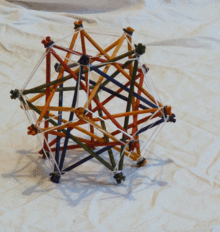
It can be constructed by arranging five tetrahedra in rotational icosahedral symmetry (I), as colored in the upper right model. It is one of five regular compounds which can be constructed from identical Platonic solids.
It shares the same vertex arrangement as a regular dodecahedron.
There are two enantiomorphous forms (the same figure but having opposite chirality) of this compound polyhedron. Both forms together create the reflection symmetric compound of ten tetrahedra.
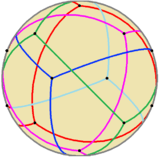 As a spherical tiling |
 Transparent Models (Animation) |
 Five interlocked tetrahedra |
As a stellation
It can also be obtained by stellating the icosahedron, and is given as Wenninger model index 24.
| Stellation diagram | Stellation core | Convex hull |
|---|---|---|
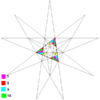 |
 Icosahedron |
 Dodecahedron |
As a facetting

It is a faceting of a dodecahedron, as shown at left.
Group theory
The compound of five tetrahedra is a geometric illustration of the notion of orbits and stabilizers, as follows.
The symmetry group of the compound is the (rotational) icosahedral group I of order 60, while the stabilizer of a single chosen tetrahedron is the (rotational) tetrahedral group T of order 12, and the orbit space I/T (of order 60/12 = 5) is naturally identified with the 5 tetrahedra – the coset gT corresponds to which tetrahedron g sends the chosen tetrahedron to.
An unusual dual property
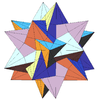
This compound is unusual, in that the dual figure is the enantiomorph of the original. If the faces are twisted to the right then the vertices are twisted to the left. When we dualise, the faces dualise to right-twisted vertices and the vertices dualise to left-twisted faces, giving the chiral twin. Figures with this property are extremely rare.
See also
References
- ↑ Regular polytopes, p.98
- Wenninger, Magnus (1974). Polyhedron Models. Cambridge University Press. ISBN 0-521-09859-9.
- H.S.M. Coxeter, Regular Polytopes, (3rd edition, 1973), Dover edition, ISBN 0-486-61480-8, 3.6 The five regular compounds, pp.47-50, 6.2 Stellating the Platonic solids, pp.96-104
- Coxeter, Harold Scott MacDonald; Du Val, P.; Flather, H. T.; Petrie, J. F. (1999). The Fifty-Nine Icosahedra (3rd ed.). Tarquin. ISBN 978-1-899618-32-3. MR 676126. (1st Edn University of Toronto (1938))
External links
- Metal Sculpture of Five Tetrahedra Compound
- VRML model:
- Compounds of 5 and 10 Tetrahedra by Sándor Kabai, The Wolfram Demonstrations Project.
- Klitzing, Richard. "3D compound".
| Notable stellations of the icosahedron | |||||||||
| Regular | Uniform duals | Regular compounds | Regular star | Others | |||||
| (Convex) icosahedron | Small triambic icosahedron | Medial triambic icosahedron | Great triambic icosahedron | Compound of five octahedra | Compound of five tetrahedra | Compound of ten tetrahedra | Great icosahedron | Excavated dodecahedron | Final stellation |
|---|---|---|---|---|---|---|---|---|---|
 |
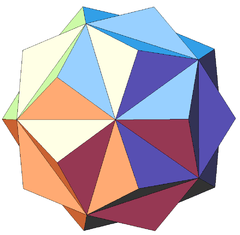 |
 |
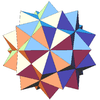 |
 |
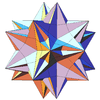 |
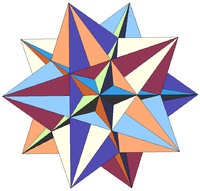 |
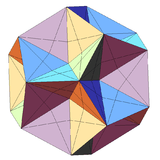 |
 | |
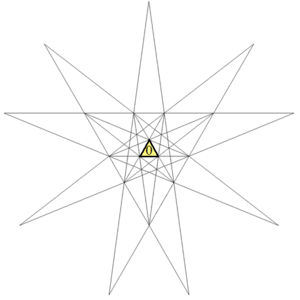 |
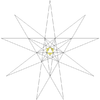 |
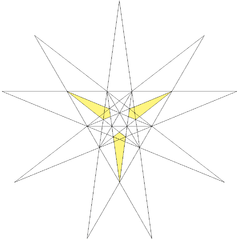 |
 |
 |
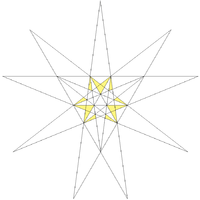 |
 |
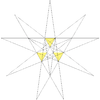 |
 | |
| The stellation process on the icosahedron creates a number of related polyhedra and compounds with icosahedral symmetry. | |||||||||